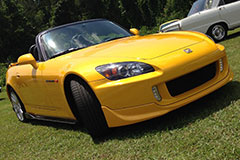Why Doesn't Honda Make a Rear-Wheel Drive Car? - Vol.350
Honda's current line-up of cars is either front-wheel drive (FWD) or all-wheel drive (AWD). However, rear-wheel drive (RWD) is the gold standard of sports cars, luxury cars, and driving enthusiasts. Why doesn't Honda appeal to them with a RWD model?

Honda's RWD history and Flirtation
This burning question is especially puzzling considering that Honda once made a well-regarded RWD car. The first-generation Honda S2000 roadster was a RWD car with spirited performance and handling. By most measures the Honda S2000 was a success in its two most important markets, Japan and the United States.
The second-generation S2000 was not as successful and it was eventually discontinued in 2009, but even before then it was rumored that Honda was working on a full-size sedan with a V8 engine and RWD drivetrain, all under the blessing of then Honda President, Takeo Fukui.
Before the exciting V8 sedan got anywhere, the world was hit by a severe economic downturn. Fukui was out and replaced by Takanobu Ito. It took no time at all for Ito to announce that there was absolutely no need for Honda to go for a V8 engine or RWD. Honda would instead concentrate on perfecting the FWD, hybrid cars, inline-four and V6 engines, and AWD which was fairly new to Honda at the time.
Ito would go on record slapping the label of "classic" on the RWD car with longitudinal engine placement and separate transmission and axle. "Classic" as in old and traditional. He would go on to say that he saw no point in trying to one-up companies that had been making RWD cars for more than five decades.
RWD: Substance and Reputation
Simply put, the substance of RWD does not always match its reputation. Ask a car buff to name his favorite sports car or muscle car or luxury car, there's no way that the car would not have a RWD drivetrain. RWD is like something to be worshipped on a pedestal. This is already a problem right off the bat. RWD's reputation can be so great that it's impossible to live up to.
First of all, RWD is reputed to have much better balance than FWD. In a FWD car, the engine, transmission and axle assembly are all in a line with the front wheel. In contrast, the weight is much better distributed in a RWD design with longitudinal engine placement, transmission in the middle of the car, and the axle assembly in the back. Better balance translates to better handling and steering, especially around corners. You'll hear car buffs using words like under-steer or over-steer to denigrate a FWD car.
The other big reputation of RWD is a much more rugged axle. With a RWD car you can run over curbs and potholes and usually nothing would happen. This is not so for a FWD car with everything loaded up front. Not to mention that the CV joints in aging Hondas are known to need replacements.
In all seriousness though, the reputation of RWD is just that ? mere reputation. The fact is most Honda owners are happy with the handling and balance of their cars, thanks to electronic traction control and other engineering advances. While it's true that RWD is more rugged, it is also a lot more expensive to build, which you'd have to pay for upfront.
Finally, it's time to talk about the clear advantage of FWD. FWD can handle rainy and snowy conditions so much better than RWD that it's not even close. This road-gripping ability in rain and snow is the result of front-loaded mass in a FWD design.It's much harder for a FWD car to hydroplane in the rain or get stuck in unploughed snow than a RWD. As a matter of fact, a RWD car is quite hopeless in the snow even with snow tires.
So you see, there simply isn't any highly compelling reason for Honda to revisit RWD.